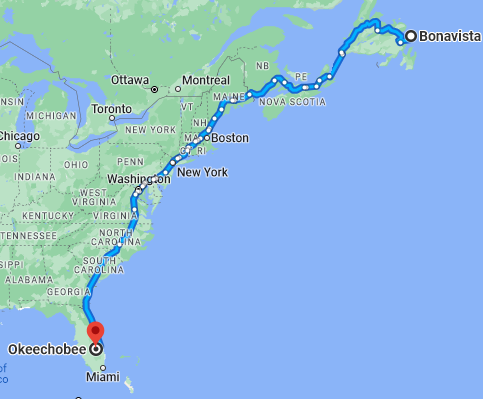709-218-7927 The Landfall Garden House 60 Canon Bayley Road Bonavista, Newfoundland CANADA A0C 1B0 |
|---|
Compostable Bags?
The specific article is headed Are compostable coffee cups actually any better for the environment? And it is one of a procession of such articles that appear about once a month in your local newspaper.
Red-Herring 1
“Many consumers are happy to swap single-use plastic for compostable packaging.” is the first red-herring.
The packaging described as single-use means only that the retailer cannot re-use the container in a new sale. Try this. Buy a coffee, drink it at the table, then return to the counter and purchase a refill. Of course the coffee-shop will refill it – they want to shave costs!
Disposable razors are just that: Razors which can be disposed (“thrown out”). It is up to the human user to decide to make a second, third use of a disposable razor. I get about twelve shaves out of a disposable razor; that’s MY decision. I will add that in a hospital environment I am all for tossing out a razor after its first use.
The consumers who are happy to swap single-use plastic for compostable packaging are nice folks; they have been persuaded to change their habits, and the main benefit to the consumer is that feel-good feeling, that “I am doing my bit to preserve the environment”. That this might be the only action they are taking flies over their heads.
Red-Herring 2
“But is it really any better than the plastic it has replaced?” Is the second red-herring?
I leave it to you to define “better” within this context. Cheaper? For you or the retailer? Taste? Feel-good (how do you measure THAT?!!???) and so on.
Unless “better” is defined, the question or statement has no measurable value.
Red-Herring 3
“It is food packaging designed to break down into soil when put in a home composting bin”
Much the same deal. Define “break down”. As our landfill sites slowly slip beneath the mantle into the earth’s crust (you know what I mean: Plate Tectonics ) then even the most stubborn plastic will break down into small molecules of hydro-carbon chains.
I have doubts about these “bio-plastics” breaking down in a regular domestic bin over a twelve-month period. Leaves, Grass, even cardboard yes. Bio-plastics? No.
Domestic composting is successful when you can use the material after a twelve-month period. I make compost just by piling it up and letting the earthworms do what they are good at. Some people turn over their heaps every month or so, and add all sorts of wonderful boosters.
But a twelve-month ROI is what we need for a domestic composter. Two years is too long a cycle for most home-gardeners.
Red-Herring 4
“It's usually made from plants such as sugarcane”. Here is an easy exercise for you to do right now. Fire up Google Maps and determine the distance between the sugar-cane plantation nearest to your home, and your home.

For me, Google Maps says a fifty-hour drive between Lake Okechobee and Bonavista. So calculate the cost of driving a 53-foot trailer of sugar-cane for fifty hours (“This route includes a ferry crossing”). That would be about the same cost as driving a trailer full of cups or bags made from sugar-cane,
So now factor in the cost of converting raw sugar-cane to bio-plastic cups and bags.
We can extend this construction as far as we want. Truck drivers need to eat along the way. They might be using re-usable cups and plates and knives and forks. There again they might not.
Using sugar-cane cups incurs massive expense in up-front cost and diesel-fuel air pollution, rubber tyre particles and so on.
And at the end of the day, I don’t see the cup or bag breaking down in twelve months in a domestic bin. Which is where a great many cups and bags could end up. We tend to buy a coffee and take it home; we tend to shop for groceries and take them home.
Forget about bio-plastic cups degrading on the side of the highway. Marketing dictates that they be decorated in bright colours. They will adorn the roadside in bright colours for years to come. Add to that the mindless dictum “Oh it’s OK, it’s bio-degradable” as idiot-boy tosses the cup out of the window,
I am not even a quarter of the way through the article, and to my mind it has failed to convince me.
So my job is to come up with an alternative.
Here it is:-
Coffee
Use your own durable (not bio-degradable) mug for coffee. You don’t need to purchase coffee at a shop that refuses to refill your grungy cup. Take your business to a coffee-shop that offers to rinse out your cup when business is slow.
Bags
Paris in the late 1970s and early 80s: People carried a string-bag in their coat pocket. No plastic handle; just all-string, compact. At the market they would purchase tomatoes, meat, and so on, enough for two or three days, and take them home in the string bag. On the way home from the office, whip out the string bag at the boulangerie, charcuterie, or corner-store. Empty the bag on the kitchen counter and stuff the string bag into your coat-pocket ready for tomorrow morning.
Summary
Less need for FOGO bins; less need for diesel trucks harvesting garbage, less need for …
709-218-7927 CPRGreaves@gmail.com Bonavista, Wednesday, November 15, 2023 9:28 AM Copyright © 1990-2023 Chris Greaves. All Rights Reserved. |
|---|